"Hahnia" obliqua is a poorly known species of meat-eating stem-mammals (cynodonts) that lived during the Upper Triassic in Europe. It is based on tiny, isolated teeth, and its affinities with other cynodonts are unclear. The generic name is not valid, thus the quotation marks. The name Hahnia has already been used for a spider. The authors are aware of this, and will doubtless come up with a new name sometime in the future.

Megazostrodon is an extinct genus of basal mammaliaforms belonging to the order Morganucodonta. It is approximately 200 million years old. Two species are known: M. rudnerae from the Early Jurassic of Lesotho and South Africa, and M. chenali from the Late Triassic of France.

Abrictosaurus is a genus of heterodontosaurid dinosaur that lived during the Early Jurassic in what is now in parts of southern Africa such as Lesotho and South Africa. It was a bipedal herbivore or omnivore and was one of the most basal heterodontosaurids. It was approximately 1.2 metres (3.9 ft) long and weighed between 0.68 and 3 kilograms.
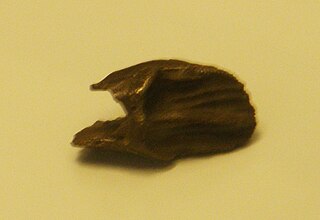
Craspedodon is an extinct genus of ceratopsian dinosaur from the Late Cretaceous Glauconie de Lonzée Formation of Belgium. Only a single species, C. lonzeensis, is known.
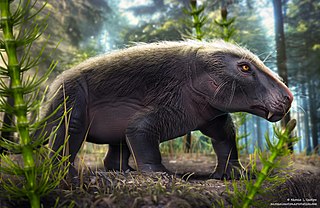
Traversodontidae is an extinct family of herbivorous cynodonts. Traversodonts were primarily Gondwanan, with many species known from Africa and South America. Recently, traversodonts have also been found from Europe and North America. Traversodonts first appeared in the Middle Triassic and diversified in the Late Triassic before going extinct at the end of the epoch. The family Traversodontidae was erected by Friedrich von Huene in 1936 for cynodonts first found in São Pedro do Sul in Paleorrota, Brazil.
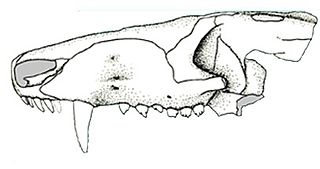
Prozostrodon is an extinct genus of probainognathian cynodonts that was closely related to mammals. The remains were found in Brazil and are dated to the Carnian age of the Late Triassic. The holotype has an estimated skull length of 6.7 centimetres (2.6 in), indicating that the whole animal may have been the size of a cat. The teeth were typical of advanced cynodonts, and the animal was probably a carnivore hunting reptiles and other small prey.

Haramiyida is a possibly polyphyletic order of mammaliaform cynodonts or mammals of controversial taxonomic affinites. Their teeth, which are by far the most common remains, resemble those of the multituberculates. However, based on Haramiyavia, the jaw is less derived; and at the level of evolution of earlier basal mammals like Morganucodon and Kuehneotherium, with a groove for ear ossicles on the dentary. Some authors have placed them in a clade with Multituberculata dubbed Allotheria within Mammalia. Other studies have disputed this and suggested the Haramiyida were not crown mammals, but were part of an earlier offshoot of mammaliaformes instead. It is also disputed whether the Late Triassic species are closely related to the Jurassic and Cretaceous members belonging to Euharamiyida/Eleutherodontida, as some phylogenetic studies recover the two groups as unrelated, recovering the Triassic haramiyidians as non-mammalian cynodonts, while recovering the Euharamiyida as crown-group mammals closely related to multituberculates.
Tricuspes is an extinct genus of cynodonts that lived in what would be Europe during the Triassic from 203.6 to 199.6 mya, existing for approximately 4 million years. Three species are known: Tricuspes tubingensis, Tricuspes sigogneauae and Tricuspes tapeinodon, which are all from the Late Triassic (Rhaetian) period in continental Europe.

Kuehneotherium is an early mammaliaform genus, previously considered a holothere, that lived during the Late Triassic-Early Jurassic Epochs and is characterized by reversed-triangle pattern of molar cusps. Although many fossils have been found, the fossils are limited to teeth, dental fragments, and mandible fragments. The genus includes Kuehneotherium praecursoris and all related species. It was first named and described by Doris M. Kermack, K. A. Kermack, and Frances Mussett in November 1967. The family Kuehneotheriidae and the genus Kuehneotherium were created to house the single species Kuehneotherium praecursoris. Modeling based upon a comparison of the Kuehneotherium jaw with other mammaliaforms indicates it was about the size of a modern-day shrew between 4 and 5.5 g at adulthood.
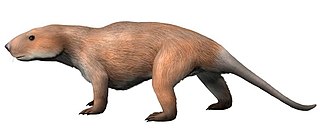
Riograndia is an extinct genus of prozostrodontian cynodonts from the Late Triassic of Brazil. The type and only species is Riograndia guaibensis, named after the State of Rio Grande do Sul and Guaíba Basin, where it was discovered. Remains have been found in the Caturrita Formation of the geopark of Paleorrota. It was a small non-mammalian cynodont, with several advanced features also present in mammals. Several specimens of Riograndia guaibensis have been found in the towns of Candelária and Faxinal do Soturno in the Caturrita Formation. The genus defines the Riograndia Assemblage Zone.
Menadon is an extinct genus of traversodontid cynodonts. The type and only species is Menadon besairiei.
Maubeugia is an extinct genus of traversodontid cynodonts from the Late Triassic of France. Isolated postcanine teeth are known from Saint-Nicolas-de-Port in northeastern France. The type species M. lotharingica was named in 1997. Many other cynodont teeth were found alongside those of Maubeugia, including those of dromatheriids, probainognathids, and other traversodontids. The size of its teeth indicates that Maubeugia was a dwarf traversodontid. The deposit in which the teeth were found indicates that it lived along the shoreline of an ocean.
Habayia is an extinct genus of traversodontid cynodonts from the Late Triassic of Belgium. A single postcanine tooth was found in Habay-la-Vieille in southern Belgium. Based on the size of the tooth, Habayia was very small. Habayia lived during the Rhaetian stage of the Late Triassic at a time when western Europe was an island archipelago due to high sea levels. The small size of Habayia may be a result of insular dwarfism.
Rosieria is an extinct genus of dwarf cynodonts from the Late Triassic of France. It belongs to the family Traversodontidae, a herbivorous group known mainly from Gondwana. The type species R. delsatei was named in 1997 on the basis of a few isolated postcanine teeth found in Saint-Nicolas-de-Port in northeastern France. These teeth were found alongside the teeth of many other cynodonts, including those of Hahnia, Gaumia, and Maubeugia. The small size of the teeth in Saint-Nicolas-de-Port suggest R. delsatei and other species were dwarf cynodonts. Most teeth in the locality belong to insectivores like dromatheriids, while those of R. delsatei and other herbivorous cynodonts are very rare.

Cricodon is an extinct genus of trirachodontid cynodonts that lived during the Early Triassic and Middle Triassic periods of Africa. A. W. Crompton named Cricodon based on the ring-like arrangement of the cuspules on the crown of a typical postcanine tooth. The epithet of the type species, C. metabolus, indicates the change in structure of certain postcanines resulting from replacement.
Kraterokheirodon is an extinct genus of enigmatic tetrapod, that was possibly an amniote, from the Late Triassic Chinle Formation of Arizona. The type and only species is K. colberti. Although it is known only from two large teeth, their shape is so unlike those of any other animal that Kraterokheirodon cannot definitively be classified under any known group of tetrapods. Its discovery also indicates that our understanding of Late Triassic tetrapod diversity is still incomplete, with Kraterokheirodon representing an otherwise unknown lineage of large tetrapod in western North America.
Dromatheriidae is an extinct family of prozostrodontian cynodonts, closely related to mammals. Members of the family are known from the Late Triassic of India, Europe and North America. Apart from a few jaw fragments, dromatheriids are mainly known from their sectorial (flesh-slicing) postcanine teeth. The teeth were fairly typical among early prozostrodontians, as they were labiolingually compressed, with a single root and crown hosting a longitudinal row of sharp cusps. Dromatheriids in particular have a very narrow and symmetrical crown without a prominent cingulum.
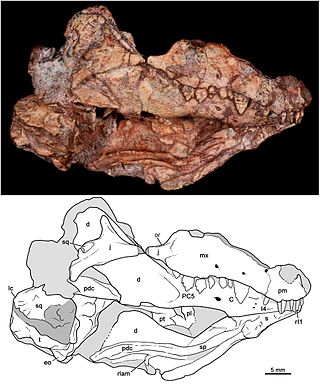
Bonacynodon is an extinct genus of cynodonts that lived in what is now southern Brazil during the Triassic period. The genus is monotypic, containing only the type species Bonacynodon schultzi. B. schultzi is known from two specimens, consisting of two partial skulls and some badly preserved parts of the postcranium. Both specimens were recovered from the Pinheiros-Chiniquá Sequence, part of the Santa Maria Supersequence of the Paraná Basin. This sequence preserves a faunal association known as the Dinodontosaurus Assemblage Zone, which contains numerous other species of cynodonts, dicynodonts and reptiles. Bonacynodon was a small, likely insectivorous cynodont, whose length has been estimated at around 30 centimetres (12 in). It can be distinguished from other cynodonts by its large, serrated (saw-like) canine teeth. Together with the genus Probainognathus of Argentina, it made up the family Probainognathidae, one of the earliest-diverging lineages of the clade Probainognathia. It was a fairly close relative of mammals, the only group of cynodonts alive today.
Rhomphaiodon is an extinct genus of prehistoric sharks in the order Synechodontiformes that has been found in Late Triassic and Early Jurassic deposits located in Europe. The type species R. minor was originally named as a species of Hybodus in 1837 by Louis Agassiz. A second species, R. nicolensis, was added when the genus was named in 1993.















